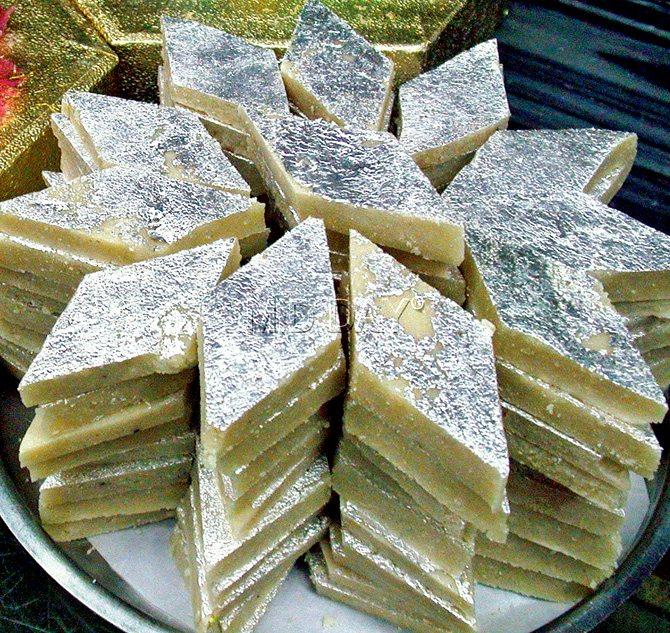My husband does not like kaju-katli (kaju barfi to some) and yet I have stayed married to him

Kaju barfi
 My husband does not like kaju-katli (kaju barfi to some) and yet I have stayed married to him. It is one of those difficult compromises you make in life. It takes a lot of courage to make a success of a relationship when there is such a fundamental difference in one’s principles. ‘The love for kaju’ transcends epicurean boundaries. It is a principle for some of us. You are either with us or against us.
My husband does not like kaju-katli (kaju barfi to some) and yet I have stayed married to him. It is one of those difficult compromises you make in life. It takes a lot of courage to make a success of a relationship when there is such a fundamental difference in one’s principles. ‘The love for kaju’ transcends epicurean boundaries. It is a principle for some of us. You are either with us or against us.
Cashew nut lovers are divided into two sides of the spectrum. Quite unlike mango lovers. You can be an Alphonso person, or a Langda, or a Safeda person, there are many castes and sub-castes to mango aficionados. Not so with kaju likers and ‘dislikers’. You either like kaju in your mithai and your pudding, or you don’t.
ADVERTISEMENT
As you might have guessed, this column is a celebration of that delicious mithai, kaju katli. Made out of cashew nut, sugar and some cardamom, this is a favorite of millions of Indians. Nothing quite makes the cut like kaju barfi. Not almonds, not walnut, not any other dry fruit. It’s that special. Pakistani visitors to India almost always carry back boxes of kaju barfi from India.

Nothing quite makes the cut like kaju barfi. Not almonds, not walnut, not any other dry fruit. File Pic
You get great badam barfis in Pakistan, but cashew barfi is an Indian specialty.
Many of us have smuggled boxes of kaju katli through customs and agriculture control in many airports. Those sniffer dogs walked past our suitcases carrying the precious cargo of kaju barfis lovingly packed in neat rows of diamond shaped delights.
I have tasted kaju barfis in many countries; they just don’t make the cut like the ones in India. There is something special about Indian mithai that is made in India. Especially mithais like rasmalai, jalebis and kaju barfis. The delicate flavour just cant be replicated elsewhere.
I never found the perfect kaju barfi in Delhi. My stock used to be sent by my chacha (father’s brother) from Mumbai. For several years, he would lovingly carry it to Delhi himself or send it via any friend or relative visiting Delhi. Chikkappa passed away last Friday. My supply of kaju katli from Chembur ended last week.
It made me wonder: was it the kaju katli that was so special, or was it my yearning to be in Mumbai with family, eating hapus mango and kaju katli every summer vacation. Some foods take us on a culinary time travel. In my mother’s side
of the family, ‘ger-beeja ajethna’ is a special dish prepared with tender cashew nuts. In my father’s side of the family, a ‘tondekai palya’ consists of some kundru/apple gourd and loads of cashews to give that crunch.
I add kaju to rice puddings and dumplings, instead of almonds like most people up north. It takes me back into my childhood. It is a feeling that is shared by many of my friends and cousins who live abroad. Certain foods trigger emotional links to one’s country of birth. I have found NRIs in America, Europe and South-East Asia aimlessly walking in the aisles of Indian grocery stores, smelling the masalas, touching the jars of pickles, gazing at gaudily coloured mithai that taste almost as awful as they look. Many hoping that food smells will close the gap of time and distance.
As we grow older, our food habits change. The foods of our childhood are the memories locked away, waiting to be recaptured in some quiet moment. Those soft echoes come back and forth, linking our place of birth or childhood with our present.
It is the link we pass on to the families we create. I was thrilled when my son showed the same obsession for kaju barfi, tondekai-beeja palya that I have, that my parents have, that my grandparents had. It isn’t just maudlin nostalgia; it is a desire to bond the past with the future that makes us hold on to food memories… an inter-generational continuity that breaks barriers of language, caste, community and geography. These recipes and tastes are mine to be bequeathed as heirlooms.
Smita Prakash is Editor, News at Asian News International. You can follow her on Twitter @smitaprakash
 Subscribe today by clicking the link and stay updated with the latest news!" Click here!
Subscribe today by clicking the link and stay updated with the latest news!" Click here!







